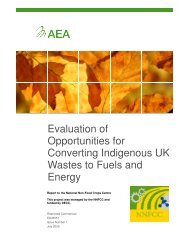Consumption and the environment (SOER2010) - European ...
Consumption and the environment (SOER2010) - European ...
Consumption and the environment (SOER2010) - European ...
Create successful ePaper yourself
Turn your PDF publications into a flip-book with our unique Google optimized e-Paper software.
Thematic assessment | <strong>Consumption</strong> <strong>and</strong> <strong>the</strong> <strong>environment</strong><br />
information‐based instruments like information on fuel<br />
consumption <strong>and</strong> CO 2<br />
emissions of new cars, voluntary<br />
agreements with industry including voluntary targets<br />
on fuel efficiency <strong>and</strong> education such as eco‐driving<br />
campaigns (ETC/SCP, 2009 <strong>and</strong> Böhler et al., 2009).<br />
These measures are most effective when applied in<br />
an appropriate mix, complementing each o<strong>the</strong>r <strong>and</strong><br />
targeting relevant actors, ra<strong>the</strong>r than used on <strong>the</strong>ir own.<br />
Fur<strong>the</strong>rmore, as <strong>the</strong> drivers of dem<strong>and</strong> for transport<br />
are often outside <strong>the</strong> transport policy area, for example<br />
in spatial patterns, urban design, <strong>and</strong> production <strong>and</strong><br />
distribution systems, transport policy must be integrated<br />
with o<strong>the</strong>r policies, particularly within urban <strong>and</strong> regional<br />
planning <strong>and</strong> health planning (EEA, 2007).<br />
Some economic instruments used to discourage car use<br />
are included in Box 6.1. However, if such instruments are<br />
to be effective, <strong>the</strong>y must be combined with investment<br />
in viable alternatives such as effective public transport<br />
systems <strong>and</strong> bicycle lanes, <strong>the</strong>reby making sustainable<br />
alternatives attractive. Bicycle action plans such as those<br />
implemented in Denmark <strong>and</strong> Germany (TRM, 2007 <strong>and</strong><br />
BMVBS, 2002) <strong>and</strong> city‐bike systems <strong>and</strong> investments<br />
in cycling infrastructure such as <strong>the</strong> United Kingdom's<br />
Cycling City, Cycling Town could be used to promote<br />
cycling in place of motorised transport.<br />
Integrating sustainable mobility concepts into urban<br />
planning is also crucial. For example, <strong>the</strong> EC's 2009<br />
Urban Mobility Action Plan (EC, 2009b) develops<br />
measures identified in <strong>the</strong> <strong>European</strong> Green Paper<br />
on Urban Transport (EC, 2007). It highlights <strong>the</strong><br />
responsibility of local, regional <strong>and</strong> national authorities<br />
in developing urban mobility policies that have <strong>the</strong><br />
promotion of sustainable transport at <strong>the</strong>ir core.<br />
One <strong>the</strong>me in <strong>the</strong> plan, The optimisation of urban<br />
mobility, describes <strong>the</strong> importance of affordable <strong>and</strong><br />
family‐friendly public transport solutions to promote<br />
reduced car‐dependence.<br />
A study carried out for <strong>the</strong> <strong>European</strong> Commission<br />
concludes that GHG emissions from transport in <strong>the</strong><br />
EU could be reduced by 89 % by 2050 compared with<br />
1990 levels if all <strong>the</strong> options currently available are<br />
embraced with bold actions. To achieve such reductions,<br />
non‐technical measures, including better spatial planning<br />
<strong>and</strong> use of economic instruments to internalise <strong>the</strong><br />
externalities of transport as well as removal of harmful<br />
subsidies, etc. are essential (EC, 2010).<br />
Box 6.1 Use of economic instruments in <strong>the</strong> area of transport<br />
Pricing of passenger transport can focus on different issues: ownership <strong>and</strong> size of cars (vehicle tax), fuel consumption<br />
(energy tax or green taxes), <strong>and</strong> <strong>the</strong> use of transport infrastructure (road‐pricing, congestion charging, parking fees)<br />
(Böhler et al., 2009).<br />
Feebate systems that combine a fee <strong>and</strong> a rebate have been introduced in several EU Member States. Examples<br />
include <strong>the</strong> French Bonus‐Malus scheme <strong>and</strong> <strong>the</strong> Danish differentiated registration levy. These systems introduce<br />
CO 2<br />
emission rates in <strong>the</strong> registration of cars combining elements of both a fee <strong>and</strong> a rebate thus providing a price<br />
incentive for cars with lower CO 2<br />
emissions. A recent study (JRC/IPTS, 2009) found that <strong>the</strong> feebate instrument could<br />
benefit both <strong>the</strong> <strong>environment</strong> <strong>and</strong> <strong>the</strong> economy.<br />
Green taxes on fuel consumption have already been implemented in several <strong>European</strong> countries ei<strong>the</strong>r as fuel taxes or<br />
as carbon taxes. In <strong>the</strong> United Kingdom <strong>and</strong> Germany <strong>the</strong> <strong>environment</strong>al benefits included reductions in fuel use <strong>and</strong><br />
emissions, <strong>and</strong> vehicle kilometres were found to be below expectations (Green Fiscal Commission, 2009; UBA, 2005).<br />
Congestion charges, in combination with improved public transport, have proved to be very effective in reducing<br />
impacts, but to date have had only very limited application. The London congestion charge introduced in 2003 has led<br />
to a reduction in traffic by 18 %, which accounts for 150 000 tonnes of CO 2<br />
‐reduction per year (Siemens AG, 2009).<br />
Similarly, <strong>the</strong> Stockholm congestion charge, introduced in 2006, resulted in a 25 % reduction in traffic during its<br />
6‐month trial period (Eliasson, 2007; Pike, 2010). A study for Switzerl<strong>and</strong> showed that a nationwide kilometre‐based<br />
charge could reduce traffic by 4–7 % (ARE, 2007).<br />
40<br />
The <strong>European</strong> <strong>environment</strong> | State <strong>and</strong> outlook 2010








